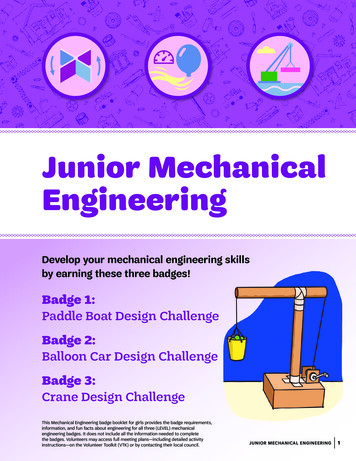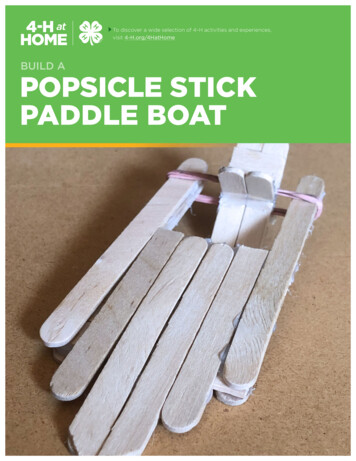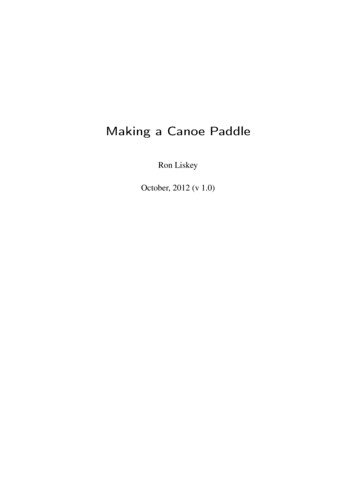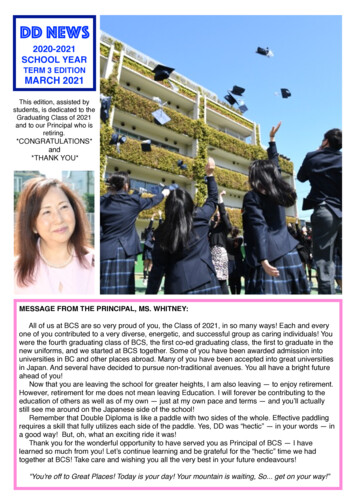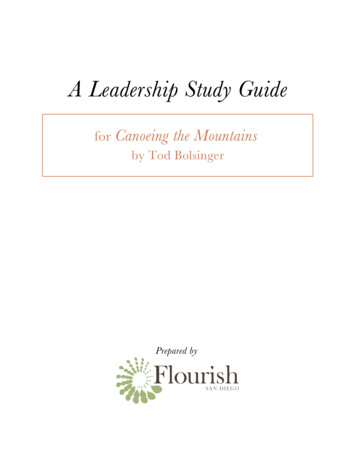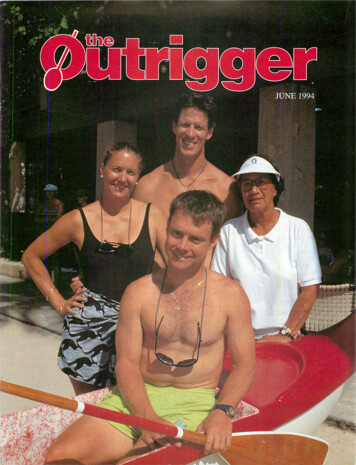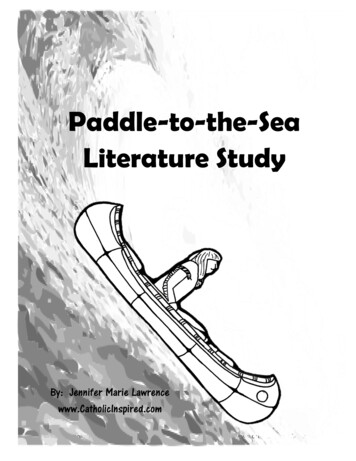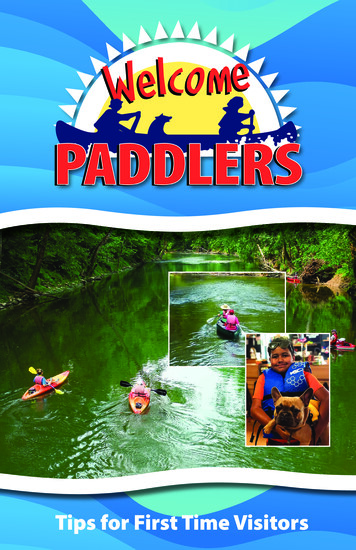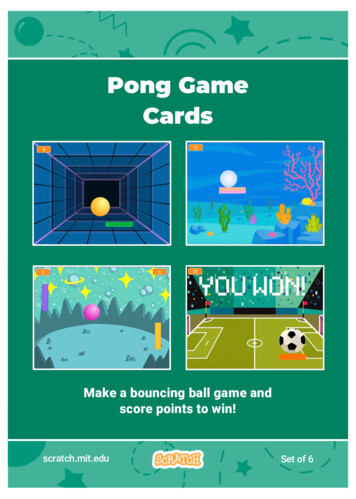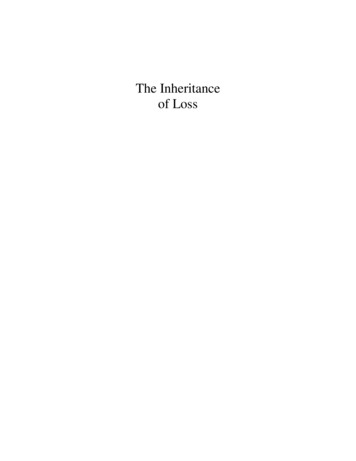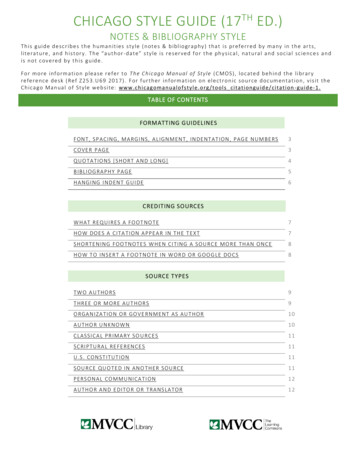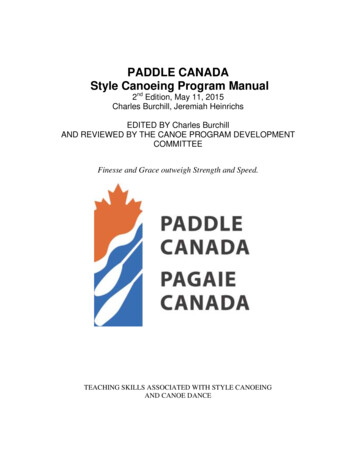
Transcription
PADDLE CANADAStyle Canoeing Program Manual2nd Edition, May 11, 2015Charles Burchill, Jeremiah HeinrichsEDITED BY Charles BurchillAND REVIEWED BY THE CANOE PROGRAM DEVELOPMENTCOMMITTEEFinesse and Grace outweigh Strength and Speed.TEACHING SKILLS ASSOCIATED WITH STYLE CANOEINGAND CANOE DANCE
Thoughts on the ProgramI (Charles) have to admit having a hard time developing/thinking about this discipline forteaching since, for me, style paddling is an individual pursuit; a meditative andexperiential activity. Criteria are difficult to judge/teach except on an individual orpersonal basis – there is a lot of latitude in the possible content and requirements. I amcontent if someone has a chance to feel and appreciate the motion of the canoe.Charles Burchillfrom a fellow canoeist“. I was trying really hard to do my skills correctly which made for very ridged andchoppy movements, not relaxed in any way. As I remember it, you showed me how to doweight turns but not to end up any particular spot, instead just to feel the movement.That was the moment for me. From there I found the perfect pivot (I love spinning circles)and you matched my circles with your canoe so the bows just missed each other in perfecttiming. It was beautiful and most importantly, I finally felt connected, a feeling ofconfidence to be built upon. I believe that is the core of this course.” Sharon Touchette.“There is a vitality, a life force, a quickening that is translated through you into action,and there is only one of you in all time, this expression is unique, and if you block it, itwill never exist through any other medium; and be lost. The world will not have it. It isnot your business to determine how good it is, not how it compares with other expression.It is your business to keep it yours clearly and directly, to keep the channel open. You donot even have to believe in yourself or your work. You have to keep open and awaredirectly to the urges that motivate you. Keep the channel open. No artist is pleased. Thereis no satisfaction whatever at any time. There is only a queer, divine dissatisfaction, ablessed unrest that keeps us marching and makes us more alive than the others.” Martha Graham 2015 All Rights Reserved Paddle Canada Style Program Manual 2nd Edition (Spring Update)i
Table of ContentsStyle Canoeing Program . 1Paddle Canada . 5Paddle Canada's Mission Statement: . 5Core Level Requirements . 7Style Canoeing Introduction - Solo. 7Style Canoeing Intermediate - Solo . 10Style Canoeing Advanced - Solo . 12Style Canoeing Progression Chart . 14Resource Material . 15Core Skills & Manoeuvres . 15MITH Concepts . 16Correction and Detection Pyramid. 18Training Pyramid . 18Basic Core Skills . 20Combination Core Skills (Manoeuvres) . 22Strokes. 30The Paddle . 35Boat Shape . 36Weight Placement (Trim/Heel) and Pivot Points. 37Kneeling positions and alternatives . 41Assessment - Corridor, Pitch, Yaw, Roll, Transition . 43Warm-up Activities . 46Practice Activities (tips and tricks) . 47Choreography . 51Sample Routines . 54Solo . 55Duet . 56Trio . 57Quad . 58Resources . 59Books . 59Videos . 59Online . 59Festivals and Events . 60Organizations . 61Instructor Certification . 62Skills and Manoeuvre Summary . 64Example Course Outlines and Material . 66A Style Clinic . 66Skills for Clinics . 68An Introductory Style Canoeing Course . 69An Intermediate Style Canoeing Course. 74Minimum Required Safety Equipment . 77A Final Thought . 78 2015 All Rights Reserved Paddle Canada Style Program Manual 2nd Edition (Spring Update)ii
Paddle Canada Contact InformationPaddle Canada Pagaie CanadaPO Box 126, Kingston, ON K7L 4V6Website: www.paddlingcanada.comE-mail: info@paddlingcanada.comToll free: 1-888-252-6292Telephone: (613) 547-3196Facsimile: (613) 547-4880Skype: paddlecanadaDisclaimer:The author/publisher of this book accepts no responsibility for injury, or loss of life while usingthe information in this publication. The material presented is for use as reference only; it is thesole responsibility of the canoeist to determine whether or not he/she is qualified to safely navigateany water situations, trails and road conditions, and to accurately assess present conditions inrelation to published material. Before choosing to navigate any passage you must evaluate foryourself: water volume, water and air temperature, skills, fatigue, value/waterproofness of load,isolation, feasibility of rescue and risk to your equipment.Acknowledgements:Charles and Jer would like to thank all of those individuals that read, commented on, andencouraged the development of this initial program; your input was invaluable. Kathy Burchill,Eric Gyselman, Sharon Touchette, Brian Johnston, Chris Milne, Priscilla Haskin, Becky Mason,Dave Wooldridge, Dot Bonnenfant, Reid McLachlan, Peter Dowd, Evan Young, Robyn Mullin.Thank you, most of all, to all of the paddlers out there – without you, what’s the point.Instructor Note:This manual outlines the skills and criteria for each level in the Style Solo paddling program. Itmay be used by instructors to create personal courses and programs, or by participants tounderstand the skills and criteria required at each level. With the exception of the section on howto become an instructor this manual should not be considered an instructor trainer manual.Copyright 201516th version of the 2nd edition. Edited by Charles BurchillAll rights reserved. No part of this work covered by the copyright herein may be produced or usedin any form or by any means: graphic, electronic, or mechanical, including taping, or informationretrieval systems, except by a reviewer, without prior permission of the publisher. Permission isgranted to current Paddle Canada instructor members to reproduce all or sections of this manualfor their own use, and for the delivery of a registered Paddle Canada course or clinic.Comments, Corrections, Suggestions:Please send any comments, corrections, or suggestions to the Paddle Canada Canoe Program DevelopmentCommittee (PDC) chair (canoepdc@paddlingcanada.com). Your thoughts and ideas will be forwarded toCharles and Jeremiah. 2015 All Rights Reserved Paddle Canada Style Program Manual 2nd Edition (Spring Update)iii
Style Canoeing Program“There is nothing that is so aesthetically pleasing and yet so functional and versatile asthe canoe.” – Bill MasonThe Style Canoeing program follows in the footsteps of Omer Stringer, Bill Mason,Becky Mason, and others paddling in a classic Canadian form also called “Omering”,Canadian Style, or Classic Solo Canoeing. This is a quiet water solo paddling stylewhere the canoe is moved across the water in free flowing graceful motions and routines.Typically a traditional tandem canoe is used, paddled on one side, with only occasionalcross strokes. The canoe is heeled to the paddling side with the gunwale near the watersurface; the canoeist is quiet [sitting still almost invisible] with the focus on themovement of the canoe. Canoe Dance or Ballet is subset of Style canoeing usually withlonger routines done to music. American Freestyle (AFS) is a closely related disciplinethat typically uses smaller canoes, many dramatic static strokes, and more bodymovement. At the Advanced level an introduction to the basics of this more recent Styletechnique is included as part of this program.Paddlers will gain an intimate feel of the connection between body, water, and canoe. Bythe end of the program they will be able to take the canoe through a series of preciselycontrolled quiet water routines as a single paddler or as part of a group. Participants willfinish each course with a good understanding of the effect of hull shape, edging, bodyposition, and strokes. Advancement from one level to the next will mean extending basicmanoeuvres into routines with tighter corridors along with mastering new skills and newmanoeuvres.The Style program is divided into three broad steps:- Introduction. Basic introduction to the concepts and forward control, weightturns, pivots, basic reverse skills- Intermediate. Controlled weight turns, intro to variety of reverse manoeuvres, andsimple routines.- Advanced. Controlled reverse skills, advanced routines, weight shift and staticstrokes (Intro to American Freestyle).Although Style canoeing is typically done in a small protected area with little wind orcurrent, the ability to precisely control a canoe has direct application in more generalLake and Moving water situations. Many moving water canoeists practice style paddlingtechniques to hone their skills and apply them in swift water conditions.“Canoes don't tip, people just fall out of them” – Omer StringerProgram GoalParticipants will learn precise paddling skills that display graceful and fluid motions ofthe canoe during manoeuvres and routines showing a high level of precision boat controlin a quiet water environment. 2015 All Rights Reserved Paddle Canada Style Program Manual 2nd Edition (Spring Update)1
Ratios for Style Canoeing ProgramIntroduction to Advanced levels are taught with a maximum ratio of one instructor to sixstudents (1:6)Course LengthMinimum time required to complete each course- Introduction: 8 hourso 16 hours will be required if the participant does not have the required LakeSolo Skills- Intermediate: 8 hours- Advanced: 8 hoursParticipants should expect to practice at least two additional hours for every hour ofinstruction time. Instructors may want to include this time as part of the course (e.g.Intermediate Style Canoeing would become a three day course). Courses may be run overmultiple days, or weeks, allowing time to practice manoeuvres, and/or develop andchoreograph routines.Although the style program can be entered directly with Intro Solo canoe skills the actualpaddling skills, even at the intro style level, are quite difficult and a high level ofprecision is required. Paddle Canada recommends the people interested in the stylepaddling program have completed at least Intermediate Lake Solo and instructorcandidates should consider mastering Advanced Lake Solo.LocationSince Style canoeing focuses primarily on canoe control on quiet water only a small areais required. A pool, sheltered pond, or small lake with 50m open water is usuallyadequate – larger groups may require more space. The water should be deep (1.5m ormore) and free of obstructions or weeds allowing the deep paddle placement required ofmany of the strokes used in Style canoeing.Criteria (Corridors) for Core SkillsAt each level general criteria are identified in parenthesis after each core skill in theorder: corridor, length, and yaw. Corridors and length are measured from the canoeist.The corridor is the total variation around the line of travel allowed (e.g. 2m would be 1meach side of the center line). Length is from start to finish in one direction. Yaw ismeasured as the degrees rotation from the expected alignment of the canoe along the lineof travel (e.g. 20 permitted yaw might be 10 on each side of the normal course oftravel). Although there is no specific measured criterion for roll it should be minimaland appropriate to the style skill being demonstrated. Even though corridors have beensuggested paddling with finesse and control through a routine is more important thanmeeting very rigorous single manoeuvre criteria.Warm-upStyle canoeing requires good flexibility and often uses paddling positions/movements 2015 All Rights Reserved Paddle Canada Style Program Manual 2nd Edition (Spring Update)2
that may stress muscles and joints. A proper warm-up and cool-down is critical beforeand after any Style paddling to prevent injury.BalanceA strong sense of balance is a required skill in all style paddling as the canoe is oftenedged or tipped to the point that the gunwale touches the water, body placement mayeven be shifted outside of the canoe and supported by a strong brace. Participants shouldbe encouraged to participate in other activities that improve core strength and balance(e.g. Yoga, trail riding, Tai Chi, kneeling or standing on a Pilates ball, standing on onefoot [with eyes closed], ballet or other dance, skiing (cross country, downhill, telemark),sit-ups/crunches/fishies, etc and actually canoeing ).Boat and PaddleStyle canoeing takes its history and development from paddling traditional tandem lakeand tripping canoes; the program reflects this heritage. The traditional canoe used forCanadian Style paddling is a symmetrical tandem boat with some rocker, soft chines,central thwart or yoke, and shallow arch bottom. This style of paddling generally uses apaddle with a shorter shaft, compared to paddling tandem, and a long blade (otter tail orquill). The grip should be symmetrical and the shaft straight as rolling strokes and powerface changes are common. Although the style of paddling (heeled and paddling on oneside) typically uses a larger tandem canoe there is no reason that the same skills cannot beused in smaller solo boats.American Freestyle usually uses smaller solo canoes often with no centre thwart; theremay be a solo seat or kneeling thwart. Cross strokes and weight shifts are easier tocomplete in these smaller narrow boats. The paddle used has a longer shaft and largebroad blade. The larger blade allows stronger braces and more significant powertransmission during the static portion of strokes. When considering boats for AFSpaddling keep in mind that the weight of the paddler can make a considerable differenceto the way a canoe will react; paddler and boat size should be matched. Look for a boatwith some rocker, narrow entry lines, and fairly full or rounded along the length of thecanoe, but still narrow enough to comfortably execute cross strokes.The program developers and instructors recognize that there is a continuous variationbetween boat shapes and the program may be appropriately modified to account fordifferent boats and how they move through the water. Students should recognize that askill learned in one kind of boat may not work in another boat; in some cases the samebody position and heel may produce an apparently opposite effect. It is theresponsibility of the instructor to adjust teaching methods and suggestions accordingly,and to explain the differences.Core skills, Manoeuvres, RoutinesA core skill is a simple motion (e.g. straight line or pivot) that continues over a defineddistance or period of time. Core skills are the very basic foundation of all Style canoeing,in this program there is a suggested criterion for each skill. There are two levels of coreskills identified in this program: simple motions such as straight lines and pivots; and 2015 All Rights Reserved Paddle Canada Style Program Manual 2nd Edition (Spring Update)3
more complex or compound skills that involve two or more basic movements such asturns which include both a line and arc or pivot.Manoeuvres are a core skills (e.g. pivot) executed along a defined pattern (line pivots)that are completed in open water without markers or criteria – manoeuvres allow studentsto show individual expression and style. Although no criteria are specified each openwater manoeuvre must be executed smoothly with minimal unintentional rocking andsplashing. Starting at the intermediate level open water manoeuvres must be completedon both paddling sides. Students should be encouraged to attempt manoeuvres thatexpand beyond the set listed in this manual – be imaginative, try new skills.Routines are a series of smoothly interconnected manoeuvres on open water that allowthe canoeist to display control over the canoe and personal style and interpretation. Thetransition between one manoeuvre and the next is just as important as the manoeuvreitself – transitions should be intentional and controlled. Each level has an increasedrequirement to put together routines as an individual (single canoe) or as part of a group.There is no requirement to set routines to music but the addition of music may assist inthe interpretation, timing, and artistry of the display. At advanced levels expect to spendseveral hours developing, choreographing, and executing even short routines.AssessmentAt each level assessment is based on the completion of core skills within the identifiedcriteria as set by the instructor, open water manoeuvres, and routines. Although paddlingstrokes are taught within each level assessment is primarily based on the movement andcontrol of the canoe in routines rather than execution of specific strokes. At theintermediate level and above transitions between manoeuvres must be executed in amanner appropriate to the routine – controlled, well timed, and continuous (asappropriate).The end point of style paddling is open water manoeuvres and routines. Assessment ofcore skills with buoys and/or a dock should only be used to show the level of boat controlneeded during more open water displays and must not be the focus or end point of theskills in this program. Instructors and candidates may choose not to use markers at all forthis reason.PrerequisitesIndividuals entering the Introductory Style canoeing course should have at least thePaddle Canada Introduction to Lake Solo or be paddling at an equivalent level at thediscretion of the instructor (e.g. old Paddle Canada Flatwater D certification, ORCKABasic Level 4 solo, ORCKA Style Paddling Level 2 (solo), ACA Freestyle level 1).Entry into the course without the prerequisite skills will mean at least an extra day ofinstruction. There is some degree of overlap between the skills required in other PaddleCanada paddling programs but the focus on control and routines make this streamdifferent and challenging.Note Regarding Paddle Canada Lake Solo 2015 All Rights Reserved Paddle Canada Style Program Manual 2nd Edition (Spring Update)4
The Paddle Canada Lake Solo program and Style Program have some overlappingpaddling skills especially at the Advanced Lake Solo level. The Lake Solo program is avery practical course that includes not only paddling skills, including paddling in adverseconditions (wind/waves), but also requirements in the practical end of planning day trips,understanding weather, navigation, ropes/knots, a range of emergency situations, groupmanagement, open water considerations, etc. The style program focuses almost solelyon paddling skills and routine development, going beyond just the practical skill to ahigher level of finesse and artistry. The need for exact skills becomes apparent whenpaddling routines where the motion of every canoe must be completely and appropriatelysynchronized or complementary. The style program also requires significantly strongerreverse and non-dominant side paddling skills.Paddle CanadaAt each level there will be a discussion of how this program fits into the overall PaddleCanada paddling program, expectations for the particular course, choosing an appropriateenvironment, course limitations, and resources for expanding skills and knowledgeparticular to the current course. The Style Paddling program may be considered an offshoot or branch of the Lake paddling program that is dedicated to boat control in a quietwater setting.Paddle Canada's Mission Statement:To promote all forms of recreational paddling emphasizing safety & instruction,to Canadians of diverse abilities, culture and ages and to thus deepen ourcollective appreciation of our land and paddling heritage.Paddle Canada values the following as part of its activities:SafetyWe promote and teach the safe use of canoes, kayaks and SUP.Educational ProgramsWe train our instructors to certify people in the knowledge & skills of safe andenjoyable canoeing, kayaking and stand up paddle boarding.Environmental AwarenessWe help develop a love and respect for our natural resources.HeritageWe nurture understanding of the place of the canoe and the kayak in our Canadianheritage.The Four Priorities of Paddle Canada are:1. Public Awareness & Membership2. Youth3. Partnerships4. Instructor DevelopmentThe 10 Objectives of the Association are as follows:1. Increase opportunities to belong to and that support Paddle Canada;2. Create and implement a communication plan with measurable results to connectthe national paddling community;3. Increase the number of youth participating in Paddle Canada programs; 2015 All Rights Reserved Paddle Canada Style Program Manual 2nd Edition (Spring Update)5
4. Increase the number of existing organized youth paddling programs that utilizePaddle Canada programs;5. Harness the full potential of existing partnership relationships;6. Identify and foster new relationships aligning with the Vision;7. Evaluate costs / benefits of partnerships annually;8. Increase instructor development opportunities at all levels;9. Identify opportunities for enhanced accessibility of the Paddle Canada programs;10. To provide a forum for the Provincial and Territorial AssociationsPaddle Canada Programs Canoeingo Waterfront programo Canoeing Basicso Lake Canoeo Moving Watero Canoe Trippingo Canoe Polingo Coastal Canoeingo Big Canoe Programo Style Canoeing Sea Kayaking River Kayaking Stand Up PaddleboardMore information on the Paddle Canada programs can be found on the website:http://www.paddlecanada.com/Style 2015 All Rights Reserved Paddle Canada Style Program Manual 2nd Edition (Spring Update)6
Core Level RequirementsThis section provides a brief goal for each level along with minimum core skills,manoeuvres, and routine requirements that must be completed. An explanation ofspecific skills, theory, and background material can be found in the resource section ofthis manual or the more general Paddle Canada resource manuals.“Technique is what you fall back on when you run out of inspiration” - Rudolf NureyevStyle Canoeing Introduction - SoloThe Introductory course provides the foundation for Style canoeing. Basic core skillswill be covered and the ability to paddle in precisely controlled manoeuvres will bedeveloped. At this level candidates must be able to complete the core skills and openwater manoeuvres on one paddling side; they should also be encouraged to attempt theskills on both sides. Students will develop a good understanding of the MITH concept inrelation to boat control in the forward direction, and an introduction to reverse.Core Skills (corridor/length/yaw)- Canoe lift and carry- Launch and removal from water at shore/dock- Balance – esp with respect to heel- Controlled sit (0,0,0)- Inside pivot (three complete revolutions) (2m, N/A, N/A)- Outside pivot (three complete revolutions) (2m, N/A, N/A)- Forward straight line ( 2m, 25m, 20 )- Reverse straight line ( 2m, 25m, 20 )- Controlled stops (forward & reverse) ( 2m, 3m, 20 )- Side displacement with 90 outside corner (both directions) ( 1m, 10m, 20 ),- Forward inside Circles (two) ( 2m, 5m radius, 20 )- Forward outside Circles (two) ( 2m, 5m radius, 20 )- Forward controlled turns in both directions ( 2m, 5m, 90 ) (5m is from initiationto completion 1 boat length) – Stop turns, pivot turns, and U turns are allincluded- Forward weight Turns in both directions, heeled to paddling side (no criteria, butconsistent selection of direction of turn)- Reverse weight turns (no criteria, introduction to skill only)Safety and Rescue- Swim 15m towing swamped canoe and empty in shallow water- Canoe over Canoe or parallel rescue, & supported re-entry from deep water- Self-rescue techniques (swimming with canoe, shallow water recovery/empty).Use of techniques such as splash out or Capistrano flip may be covered.- Attempted Solo re-entry into the canoe from deep waterAlthough these items are not critical for Style canoeing they are often needed whenlearning or practicing as accidental tipping is not uncommon. 2015 All Rights Reserved Paddle Canada Style Program Manual 2nd Edition (Spring Update)7
Instructors will ensure that the participants are aware of all of the necessary skills andappropriate treatment of equipment at each level. Skills listed in this section are forcompleteness if participants have shown that they have the necessary skills then furtherinstruction may not be required (e.g. lifts/carries, launch, canoe-over-canoe).Paddling Strokes – Blending of strokes and palm rolls will be introduced at this levelalong with a discussion of placement, catch, follow-through, completion, recovery, andassociated forces and torque. Although the program is primarily focused on movement ofthe canoe a set of strokes is helpful to know and understand for communication.- J, Canadian, or knifing J- Rolling J (silent stroke)- Reverse J- C stroke- Draw, Push away/pry – both off-set and for side displacement- Sculling in both directions (side displacement)- Forward stroke- Box stroke along with variations (pivots)- Reverse stroke and compound back stroke- Running pry, jam (turns)- Running draw (turns)- Sweep (forward/reverse) for both turns and pivots- Braces – in particular low and high braces, along with sculling braces.Manoeuvres- Each of the core skills will be completed in open water. Synchronized paddling ofcore skills (e.g. side-by-side paddling, interlocking pivots, circles around pivot,etc ) may be introduced at this level. Although there are no set criteria for openwater manoeuvres they should be executed smoothly without significant roll orsplash – this is the artistry of Style canoeing. Students should be encouraged totry and develop their own ideas.- Stop/check – the paddler should be able to stop each manoeuvre, eithercompletely or direction (such as in a turn).- Instructors may include a basic marked course for students to follow to mimicusing specific style skills when paddling in tight paddling conditions.- Introduction of Synchronized paddling.Routines- There is no requirement for complex routines at this level but
for their own use, and for the delivery of a registered Paddle Canada course or clinic. Comments, Corrections, Suggestions: Please send any comments, corrections, or suggestions to the Paddle Canada Canoe Program Development Committee (PDC) chair (canoepdc@paddlingcanada.com). Your
